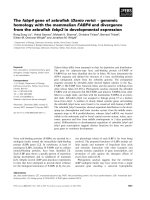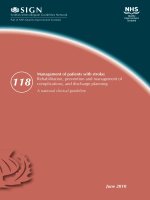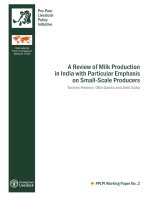Fortification needs of PGF2α with bypass fat, minerals and vitamins for treatment of silent oestrus in crossbred cows
Bạn đang xem bản rút gọn của tài liệu. Xem và tải ngay bản đầy đủ của tài liệu tại đây (373.13 KB, 6 trang )
Int.J.Curr.Microbiol.App.Sci (2019) 8(2): 1513-1518
International Journal of Current Microbiology and Applied Sciences
ISSN: 2319-7706 Volume 8 Number 02 (2019)
Journal homepage:
Original Research Article
/>
Fortification Needs of PGF2Α with Bypass Fat, Minerals and Vitamins for
Treatment of Silent Oestrus in Crossbred Cows
L.J. Dutta1*, K.C. Nath1, B.C. Deka1, D. Bhuyan1, P. Borah2, G.K. Saikia3,
D.P. Bora3, R. Deka1 and M. Bhuyan1
1
Department of Animal Reproduction, 2Department of Animal Biotechnology, 3Department of
Veterinary Microbiology, College of Veterinary Science, AAU, Khanapara,
Guwahati-781022, Assam, India
*Corresponding author
ABSTRACT
Keywords
Silent oestrus,
Crossbred cows,
PGF2α, Bypass fat,
Conception rate
Article Info
Accepted:
12 January 2019
Available Online:
10 February 2019
A study was conducted to compare efficacy of PGF2α and PGF2α fortified with bypass fat,
minerals and vitamins for treatment of silent oestrus in crossbred cows based on oestrus
induction response and post treatment conception rate. The study revealed that double
intramuscular injection of PGF2α at 11 days apart resulted in 100.00 per cent oestrus
response rate and 66.66 per cent post treatment conception rate in silent oestrous crossbred
cows. Fortification of PGF2α with supportive treatment comprising oral bypass fat, mineral
mixture and injectable phosphorus and vitamins also resulted in 100.00 per cent oestrus
response and 66.66 per cent conception rate. With supportive treatment alone only 33.33
per cent oestrus response and 33.33 per cent conception rate could be obtained. It could be
concluded that fortification of PGF2α with supportive drugs did not improve its efficacy in
the management of silent oestrus in crossbred cattle.
Introduction
Reproductive disorders in cows reduce their
breeding efficiency making them incapable of
producing a calf a year. The major
reproductive
disorders
of
economic
importance in cattle are repeat breeding and
anoestrus including silent oestrus. An
increased calving-to-conception interval as a
result of true anoestrus or sub estrus in
bovines adversely affects the economics of
the dairy sector. Silent oestrus is characterized
by lack of behavioural signs although the
genital organs undergo normal cyclical
changes. This stands as a major problem for
detection of oestrus in cows, specially on the
part of the farmer who has to report for
breeding the cow in time.
PGF2α has been used for treatment of silent
oestrus in cattle with varying results (Agarwal
and Shankar, 1997, Honparkhe et al., 2008,
Sahatpure and Patil, 2008, Kumar et al., 2011,
Venkata Ramana et al., 2013 and Jamsawat et
al., 2015).
1513
Int.J.Curr.Microbiol.App.Sci (2019) 8(2): 1513-1518
In the present study an attempt has been made
to improve oestrus manifestation and
therapeutic efficacy of PGF2α in the
management of silent oestrus in cows through
fortification with fat, minerals and vitamins in
view of the fact that Silent oestrus is
influenced by nutritional factors such as
energy deficiency and metabolic disorders.
PGF2α
PGF2α 500 µg intramuscularly repeated after
11 days (Pragma, Cloprostenol Sodium 250
mcg/ml, Intas Pharmaceuticals limited,
Ahmedabad, India).
PGF2α+ Supportive
Materials and Methods
Comprising bypass fat, minerals and vitamins
as described below.
All the experimental animals were examined
per rectum on day 0 (before treatment), day
14 (after treatment) and on the day of
subsequent oestrus to record presence of
vaginal discharge, uterine tone and ovarian
structures i. e. palpable follicle and corpus
luteum. The cows responding to treatment
were also observed for other signs of oestrus.
Cows under supportive treatment group were
inseminated on showing signs of oestrus
while PGF2α treated cows with or without
supportive treatment were inseminated on 4th
day of second PGF2α injection. Conception
rates in different treatment groups of cows
were worked out on the basis of actual
pregnancy diagnosis.
Bypass Fat (Fatomax, Intas Pharmaceuticals
limited, Ahmedabad, India) @ 150 gm per
day per animal with concentrate mixture for
20 days.
Within 3 months of A. I. Efficacy of the
treatment regimen was found out based on
percentage of cows exhibiting signs of oestrus
and subsequent conception rate.
A total of 18 crossbred cows affected with
silent oestrus divided into three groups each
comprising six cows to be treated with three
treatment regimens.
Silent oestrus was diagnosed on the basis of
absence of signs of oestrus for more than
three months post partum and detection of
palpable corpus luteum on rectal examination.
The treatment regimens were as follows.
Supportive treatment
Mineral mixture (Minfa Gold, Intas
Pharmaceuticals limited, Ahmedabad, India)
@ 30 gm daily per animal with concentrate
mixture for a period of 30 days.
Injectable Phosphorus (Tonophosphan Vet,
containing sodium salt of 4-dimethyl amino2-methyl phenyl-phosphinic acid, MSDAnimal Health, Pune, India) @ 2 gm
intramuscularly per day for three occasions at
alternate days
Vitamin A (Intavita H, Intas Pharmaceuticals
limited,
Ahmedabad,
India)@
5ml
intramuscularly for three occasions at
alternate days.
Results and Discussion
Per cent response, post treatment oestrus
interval and conception rate
Per cent response of silent oestrous cows to
different treatment regimen in terms of
manifestation of external signs of oestrus as
shown in Table 1 was recorded as 33.33,
100.00 and 100.00 for supportive, PGF2α and
PGF2α+supportive treatment groups. The
corresponding post treatment oestrus intervals
for the cows under the three treatment groups
were 27.00, 4.00 ± 0.00 and 4.00 ± 0.00 days.
The subsequent conception rates were 33.33,
1514
Int.J.Curr.Microbiol.App.Sci (2019) 8(2): 1513-1518
66.66 and 66.66 per cent for cows under
supportive, PGF2α and PGF2α+supportive
treatment regimen respectively.
Characteristic genital changes
Table 2 represents frequency of occurrence of
different genital changes in silent oestrous
crossbred cows at day 0, day 14 and day of
post treatment oestrus following treatment
with different treatment regimens.
All silent oestrus cows (100.00 per cent)
treated with supportive treatment showed
absence of vaginal discharge at day 0 as well
as at day 14 of treatment. Following treatment
only two cows responded to treatment and
showed vaginal discharge (33.33%). In cows
treated with PGF2α and PGF2α+supportive
treatment also all showed absence of vaginal
discharge on day 0 but on day 14 which was
the day of post treatment oestrus 100.00 per
cent showed vaginal discharge.
Uterine tone was absent in all silent oestrus
cows treated with supportive treatment on
both day 0 and day 14. On the day of post
treatment oestrus 33.33 per cent cows showed
good uterine tone. In both PGF2αand
PGF2α+supportive treatment groups uterine
tone was absent on day 0 but 100.00 per cent
present on day 14, which was also the day of
post treatment oestrus.
Ovaries of all cows (100.00 per cent) under
supportive treatment group showed both
palpable follicle and palpable corpus luteum
on day 0 and only follicle on day 14. In case
of both PGF2α and PGF2α+supportive
treatment groups ovary in all cows (100.00%)
showed presence of palpable follicle as well
as palpable corpus luteum on day 0 of
treatment but on day 14 or on the day of post
treatment oestrus only follicle could be
palpated in all cows.
From the results obtained on study of
different therapeutic techniques used for
addressing silent oestrus, it was clear that
PGF2α alone or PGF2α fortified with minerals
and vitamins were effective for the
management of silent oestrus in crossbred
cows. Oestrus response to both the treatment
regimens was 100.00 per cent. Post treatment
oestrus interval and subsequent conception
rate were 4.00 ± 0.00 days and 66.66 per cent
respectively in cows treated with each of the
two treatment regimens. Supportive treatment
alone was not effective in the treatment of
silent oestrus, which resulted in poor oestrus
response rate of 33.33 per cent and poor
conception rate of 33.33 per cent. Therefore,
it can be stated that fortification of PGF2α
therapy with minerals and vitamins was not
advantageous over PGF2α alone as regards to
percentage response and conception rate.
Available literature revealed very little
information on nutritional fortification need
of PGF2α treatment in the management of
silent oestrus in cattle. A good amount of
information was available on the efficacy of
single or double injection of PGF2α for the
treatment of silent oestrus in cattle from India
(Agarwal and Shankar, 1997; Honparkhe et
al., 2008; Sahatpure and Patil, 2008; Kumar
et al., 2011 and Venkata Ramana et al., 2013)
as well as abroad (Wenkoff, 1978; Kaneda et
al., 1981; Mialot et al., 1999; Zeuh et al.,
2014 and Jamsawat et al., 2015).
Sahatpure and Patil (2008) obtained 100.00
per cent oestrus response in buffaloes and
cattle respectively. Venkata Ramana et al.,
(2013) reported 81.80 per cent oestrus
response and 67.00± 0.26 per cent conception
rate in silent oestrous cows using double
injection of PGF2α given at 12 days interval
which was similar to the finding obtained in
the present study.
1515
Int.J.Curr.Microbiol.App.Sci (2019) 8(2): 1513-1518
Table.1 Per cent response, post treatment oestrus interval and conception rate in silent oestrous
crossbred cows treated with different treatment regimen
Treatment
Regimen
No. of
cow
treated
response
Supportive
6
No. showing
vaginal
discharge
2
PGF2α
PGF2α+
Supportive
6
6
6
6
%
33.33
100.00
100.00
Post treatment
oestrus interval
(days)
(Mean ±S.E.)
27.00 *
(25, 29)
4.00±0.00
4.00±0.00
Conception rate
No. of
cows
pregnant
2
%
33.33
4
4
66.66
66.66
* S.E. not calculated as the no. of observation was only 2.
Figures in the parentheses indicate individual observation on two cows
Table.2 Characteristics of vaginal discharge, uterine tone and presence of ovarian structures in
silent oestrous crossbred cows at different days of treatment with different treatment regimen
Characteristic
genital changes
Supportive treatment
(n=6)
Day 0 Day 14
Post
treatment
oestrus
Frequency of occurrence (%)
PGF2α
PGF2α+Supportive
(n=6)
(n=6)
Day 0
Day 14/
Post
Day 0
Day 14/
Post
Day of post treatment
Day of post treatment
treatment
oestrus
treatment
oestrus
oestrus
oestrus
0.00
(0)
100.00
(6)
0.00
(0)
100.00
(6)
33.33
(2)
0.00
(0)
100.00
(6)
100.00
(6)
0.00
(0)
100.00
(6)
0.00
(0)
0.00
(0)
100.00
(6)
100.00
(6)
0.00
(0)
100.00
(6)
0.00
(0)
0.00
(0)
0.00
(0)
100.00
(6)
0.00
(0)
0.00
(0)
100.00
(6)
33.33
(2)
-
0.00
(0)
16.66
(1)
100.00
(6)
100.00
(6)
0.00
(0)
0.00
(0)
100.00
(6)
0.00
(0)
0.00
(0)
0.00
(0)
16.66
(1)
83.33
(5)
100.00
(6)
0.00
(0)
0.00
(0)
100.00
(6)
0.00
(0)
0.00
(0)
100.00
(6)
100.00
(6)
100.00
(6)
16.66
(1)
33.33
(2)
-
100.00
(6)
100.00
(6)
100.00
(6)
0.00
(0)
100.00
(6)
0.00
(0)
100.00
(6)
100.00
(6)
100.00
(6)
0.00
(0)
100.00
(6)
0.00
(0)
Vaginal discharge
Present
Absent
-
Uterine tone
Good
Moderate
Absent
-
Ovarian structure
Palpable
Follicle
Palpable CL
Figures in the parentheses indicate number of observations
1516
Int.J.Curr.Microbiol.App.Sci (2019) 8(2): 1513-1518
Similarly Kumar et al., (2011) also reported
91.30 per cent oestrus induction response and
71.43 per cent conception rate in sub-oestrous
cows using single injection of PGF2α. The
conception rate obtained by Honparkhe et al.,
(2008) in sub-oestrous cows treated with
PGF2α was somewhat low (50.00 per cent).
Similar lower oestrus response rate and
conception rate in sub-oestrous cows
following PGF2α treatment had been reported
by Wenkoff (1978) from Canada, Kaneda et
al., (1981) from Japan and Mialot et al.,
(1999) from France. All these reports
indicated that post treatment oestrus interval
in silent oestrous cows following PGF2α
treatment ranged from 2-5 days. In the present
study, all the animals were inseminated on 4th
day of second PGF2α injection and showed
signs of oestrus on that day.
As regards to genital changes of the treated
silent oestrus cows detected on 14th day after
treatment also there appeared no difference i.
e. the efficacy of the two treatment regimens
in PGF2α alone and PGF2α with minerals and
vitamins. In both the treatment groups on 14th
day of treatment characteristic genital changes
were presence of vaginal discharge, presence
of good uterine tone and presence of palpable
follicle on the ovary in 100.00 per cent
animals. These findings clearly indicated that
all silent oestrous cows treated with PGF2α
with or without supportive treatment
responded to treatment. On the other hand in
silent oestrous cows under supportive
treatment there appeared no good response on
14th day of treatment. Available literature did
not reveal information on nutritional
fortification need of PGF2α for treatment of
silent oestrus in cattle.
In conclusion, it must be stated that,
fortification of PGF2α treatment with minerals
and vitamins was not advantageous over
PGF2α alone in the treatment of silent oestrus
in crossbred cows orPGF2α was effective for
treatment of silent oestrus in crossbred cows
and fortification with supportive treatment
comprising oral bypass fat and mineral
mixture and injectable phosphorus and
vitamin A did not produce better result in
terms of conception rate.
References
Agarwal, S. K. and Shankar, U. 1997. Effect
of exogenous administration of PGF2α
at different stages of oestrous cycle on
onset of oestrus and subsequent fertility
in crossbreed cattle. Ind. J. Anim.
Reprod. 18: 95-97.
Honparkhe, M., Singh, J., Dadarwal, D.,
Dhaliwal, G. S. and Kumar, A. 2008.
Estrus induction and fertility rates in
response to exogenous hormonal
administration in postpartum anestrous
and subestrus bovines and buffaloes. J.
Vet. Med. Sci. 70: 1327–1331.
Jamsawat, V., Mamuad, F. V. and Venturina,
E. V. 2015. Effects of PGF2α and
GnRH on Reproductive Performance of
Cattle and Buffaloes in Thailand and
Philippines. J. Agric. Tech. 11: 22732281.
Kaneda, Y., Domeki, I., Kamomae, H. and
Nakahara, T. 1981. Synchronization of
Estrus with ProstaglandinF2α in Cattle.
Japan Anim. Reprod. Quarterly. 15:
137-143.
Kumar, R., Butani, M. G., Dhami, A. J.,
Kavani, F.S., Shah, R.G. and Killedar,
A. 2011. Management of anestrus and
subestrus cows using hormonal and
non-hormonal drugs. Ind. J. Anim.
Reprod. 32: 24-26.
Mialot J. P., Laumonnier, G., Ponsart, C.,
Fauxpoint, H., Barassin, E., Ponter A.
A. and Deletang, F. 1999. Postpartum
subestrus in dairy cows: comparison of
treatment with prostaglandin F2 alpha
or GnRH + prostaglandin F2 alpha +
GnRH. Theriogenology. 52:901-911.
1517
Int.J.Curr.Microbiol.App.Sci (2019) 8(2): 1513-1518
Sahatpure, S. K. and Patil, M.S. 2008.
Synchronisation of oestrus with
prostaglandin F2 alpha analogue in nondescript cow. Vet. World 1: 203-204.
Venkata Ramana, K., Rao K. S., Supriya K.
and Rajanna N. 2013. Effect of
prostaglandin on estrus response and
conception rate in lactating ongole
cows. Vet. World 6: 413-415.
Wenkoff, M. S. 1978. Therapeutic evaluation
of the use of prostaglandin analogue
IC180996 in cattle. Can. Vet. J. 19:
277-278.
Zeuh, V., Youssouf, M. L., Dingamtar, N. and
Dezoumbe, D. 2014. Evaluation of two
methods of estrus synchronization of
cattle in Chad. Open J. Anim. Sci. 4:1317.
How to cite this article:
Dutta, L.J., K.C. Nath, B.C. Deka, D. Bhuyan, P. Borah, G.K. Saikia, D.P. Bora, R. Deka and
Bhuyan, M. 2019. Fortification Needs of PGF2Α with Bypass Fat, Minerals and Vitamins for
Treatment of Silent Oestrus in Crossbred Cows. Int.J.Curr.Microbiol.App.Sci. 8(02): 15131518. doi: />
1518









